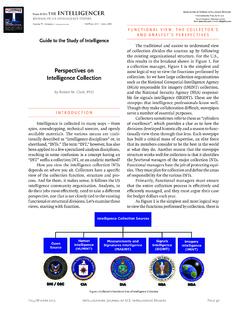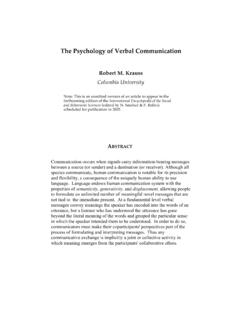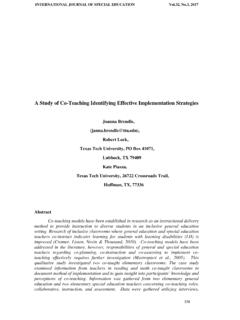Transcription of Human Capital - Harvard University
1 Handbook of Cliometrics, Claude Diebolt and Michael Haupert, editors Springer-Verlag, forthcoming. Human Capital Claudia Goldin Department of Economics Harvard University and National Bureau of Economic Research ABSTRACT Human Capital is the stock of skills that the labor force possesses. The flow of these skills is forthcoming when the return to investment exceeds the cost (both direct and indirect). Returns to these skills are private in the sense that an individual s productive capacity increases with more of them. But there are often externalities that increase the productive capacity of others when Human Capital is increased. This essay discusses these concepts historically and focuses on two major components of Human Capital : education and training, and health.
2 The institutions that encourage Human Capital investment are discussed, as is the role of Human Capital in economic growth. The notion that the study of Human Capital is inherently historical is emphasized and defended. Table of Contents I. Human Capital and History .. 1 A. What Is Human Capital ? .. 1 B. Why the Study of Human Capital is Inherently Historical .. 2 II. Human Capital and Economic Growth .. 4 A. Human Capital and Economic Performance in the Long Run: Escaping Malthus .. 4 B. Human Capital , Institutions and Economic Growth .. 5 III. Producing Human Capital : Education and Training .. 7 A. The Rise of Formal Education and the Role of the State.
3 7 B. Formal Schooling in Europe and America .. 8 C. Why Invest in Education or Training? .. 11 D. Role of the State in Education .. 13 E. Why Education Levels Increased .. 14 F. Race between Education and Technology .. 16 G. Human Capital and Education: Concluding Remarks .. 17 IV. Producing Human Capital : Health .. 17 A. Health Human Capital and Income .. 17 B. Measures of Health Human Capital .. 18 C. Increased Life Expectation: The Three Historical Phases .. 19 (1) Phase I: Improvements in Nutrition .. 19 (2) Phase II: Public Health Interventions .. 20 (3) Phase III: The Age of Modern Medicine .. 21 V. Human Capital : 22 References .. 24 Figure and Tables.
4 29 Claudia Goldin, Human Capital 2/23/2014 -1- I. Human Capital and History For much of recorded history, income levels were low, lives were short and there was little or no economic growth. We now have healthier, longer, richer and hopefully happier lives. The regime shift involved increased knowledge and its diffusion, greater levels of training and education, improved health, more migration, fertility change and the demographic transition. In short, the process involved advances in Human Capital . A. What Is Human Capital ? Human Capital is defined in the Oxford English Dictionary as the skills the labor force possesses and is regarded as a resource or asset.
5 It encompasses the notion that there are investments in people ( , education, training, health) and that these investments increase an individual s productivity. We use the term today as if it were always part of our lingua franca. But it wasn t. Not that long ago, even economists scoffed at the notion of Human Capital . As Theodore Schultz noted in his American Economic Association presidential address in 1961 many thought that free people were not to be equated with property and marketable assets (Schultz, 1961). To them, that implied slavery. But the concept of Human Capital goes back at least to Adam Smith. In his fourth definition of Capital he noted: The acquisition of.
6 Talents during .. education, study, or apprenticeship, costs a real expense, which is Capital in [a] person. Those talents [are] part of his fortune [and] likewise that of society (Smith, 1776). The earliest formal use of the term Human Capital in economics is probably by Irving Fisher in It was later adopted by various writers but did not become a serious part of the economists lingua franca until the late 1950s. It became considerably more popular after Jacob Mincer s 1958 Journal of Political Economy article Investment in Human Capital and Personal Income Distribution. In Gary Becker s Human Capital : A Theoretical and Empirical Analysis, with Special Reference to Education, published in 1964 (and preceded by his 1962 Journal of Political Economy article, Investment in Human Capital ), Becker notes that he hesitated to use the term Human Capital in the title of his book and employed a long subtitle to guard against 1 Fisher cites Nicholson, The Living Capital of the United Kingdom, for the term living Capital as opposed to dead Capital .
7 Claudia Goldin, Human Capital 2/23/2014 -2- Schultz s article (1961) demonstrates the importance of the concept of Human Capital in explaining various economic anomalies. Some are easy to figure out, such as why both migrants and students are disproportionately young persons. Some are more difficult, such as why the ratio of Capital to income has decreased over time, what explains the growth residual, and why Europe recovered so rapidly after World War II. Some are even more difficult, such as why labor earnings have risen over time and why they did not for much of Human history. As is clear from most of these issues, the study of Human Capital is inherently historical.
8 B. Why the Study of Human Capital is Inherently Historical robert Solow s pioneering work on economic growth in the 1950s led to the formulation of growth accounting and the discovery (or uncovering) of the residual. 3 Solow (1957), working with data from 1909 to 1949, demonstrated that the residual was percent of total growth in per capita terms. The residual is that portion of economic growth that the researcher cannot explain by the increase in physical productive factors such as the Capital stock, the number of workers and their hours and weeks of work. The size of the residual during much of the twentieth century relative to economic growth in per capita or per worker terms demonstrated that physical Capital accumulation did not explain much of growth and that something else did.
9 That something else is knowledge creation and the augmentation of the labor input through education and training. In other words, much of the residual was due to the increase in Human Capital . Some researchers devised methods to close the residual gap by adding Human Capital growth to the Solow model (Mankiw, Romer & Weil, 1992). Others demonstrated that the growth of knowledge and other non-rival goods meant that some of the implications of the Solow model were violated (Jones & Romer, 2010). Among the most important findings regarding economic growth over the long run, and the one most relevant to the study of Human Capital in history, is that the residual has greatly increased over time.
10 Physical Capital accumulation and land clearing explain a substantial fraction of economic growth in the past. But they do far less well in the more modern era. As a 2 A Google N Gram of the term Human Capital reveals that there was virtually no usage in the English language until the late 1950s. After the 1950s the usage of the term increased until today, with a somewhat greater uptick in the 1990s than previously. 3 For an understanding of the residual in economic growth, see the original Solow (1957) article or an economic growth theory textbook such as Barro and Sala-i-Martin (2003). Claudia Goldin, Human Capital 2/23/2014 -3- fraction of the growth of income per capita in history the residual has increased from about 57 percent for the 1840 to 1900 period to around 85 percent for the 1900 to 1980s The residual can be reduced by about 20 percent for the 1900 to 1980s period by accounting for the growth in Human Capital embodied in But growth in Human Capital does little to reduce the residual for the earlier period.















